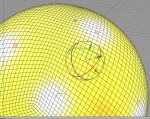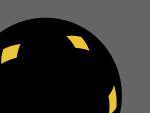Reflect-O-Matic
This script allows you to automatically create lights or geometry that will reflect onto the currently selected polygons (if more than one is selected, the "first" polygon will be picked). It was inspired by this thread.
The math is fairly straightforward: it figures out where the camera is, where the polygon is, and using that information sticks a light in the scene twice as far away from the position of the polygon as the camera is along the vector of incidence.
The images show a polygon selection, the rendered result, the rendered result with the polygon selection overlaid.
Reflect-o-matic web page.
This script allows you to automatically create lights or geometry that will reflect onto the currently selected polygons (if more than one is selected, the "first" polygon will be picked). It was inspired by this thread.
The math is fairly straightforward: it figures out where the camera is, where the polygon is, and using that information sticks a light in the scene twice as far away from the position of the polygon as the camera is along the vector of incidence.
The images show a polygon selection, the rendered result, the rendered result with the polygon selection overlaid.
Reflect-o-matic web page.
Attachments
Last edited:




